| Manufacturer: | Scratch |
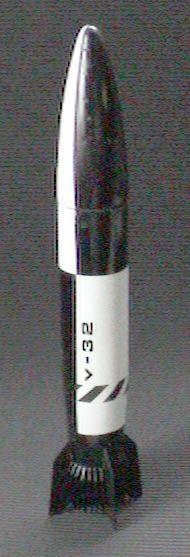
Brief:
81% Downsize of a 1970 plan.
Construction:
Handmade nose cone, 4" BT-55, 3.75" BT-50, BT-5 engine tube, mini
engine hook, engine block, two 5-50 centering rings, two 50-55 centering rings,
one BT-55 coupler, elastic shock cord, 11" parachute, 72" of extruded
0.04" x 1/4" styrene, Bristol ply for tail cone.
The V-32 plans by Melville Grant Boyd, originally published in American Aircraft Modeler July 1970 and currently are available at JimZ. It is a very intriguing concept. Basically, you have a V-2 with 32 tiny fins instead of 4 large ones. The effort herein describes a downscale (81%) to a BT-55 from the original BT-60 to allow experimentation with mini engines.
The first thing to do was to build it in RockSim. Dimensions were modified to adhere more closely to the scale design of the real V2, but you still couldn't call this a scale rocket. According to RockSim, the entire length of the scaled down fins (2.23") was not required, so they were shortened to 1.0625", which is the point at which stability begins to be reduced.
Since there were 32 fins, extruded 1/8"x.04" styrene Raboesch stock (from Hobbytown) was used to reduce build and finishing time. A tail cone was created instead of the straight body tube of the original design, but the recessed engine mount (recessed by 1/2" to enhance stability) was retained. The tail cone shroud was created in Freehand using blends to create exactly spaced fin alignment guides on Bristol ply paper, but it still took 2 hours to cut and attach the 32 fins. They were smoothed a little bit and glued on with CA gel.
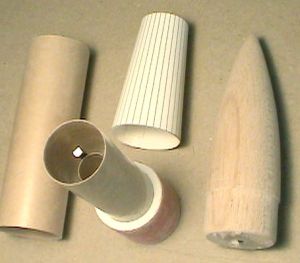 The nose cone was
hand turned on a drill, hollowed out, and 0.35oz of lead was epoxied into the
tip in order to achieve a static stability margin of 1.06. Projected altitude
was a little over 200 ft.
The nose cone was
hand turned on a drill, hollowed out, and 0.35oz of lead was epoxied into the
tip in order to achieve a static stability margin of 1.06. Projected altitude
was a little over 200 ft.
A 1/8" shock cord was added using standard folded paper mounts with a loop at the nose cone for the parachute attachment. An 11" parachute was used.
Flight:
It swing tested OK, flying sideways at lower speeds and stable at higher
speeds.
Prep is quick and easy because of the motor hook, with lots of space for the small parachute and wadding.
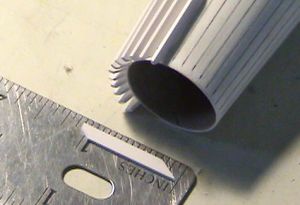 The first flight
on a A10-3T at CRASH in Denver on 4/3/05 was unstable. The V-32 was quick off
the pad and landed safely in an adjacent field before deployment. Some minor
damage to the nose cone was easily repaired.
The first flight
on a A10-3T at CRASH in Denver on 4/3/05 was unstable. The V-32 was quick off
the pad and landed safely in an adjacent field before deployment. Some minor
damage to the nose cone was easily repaired.
The next day, it was launched on a A10-3T again in a park with 0.25oz additional lead. Again it was unstable with minimal damage.
Two days later, it was launched on a A10-3T again with a total of 0.69oz of weight. Marginally unstable, it deployed the parachute at ~10ft and was recovered with no damage.
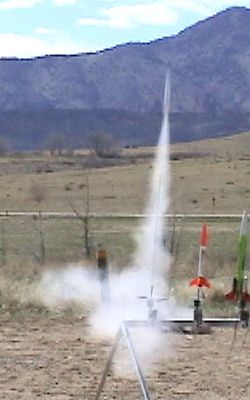 Since the
incrementally added weight resulted in increasingly wimpy altitudes in RockSim,
an executive decision was made to replace 4 of the 0.125" fins with
0.25" fins. Following this transplant operation on 4/9/05, it was launched
on a 1/2A3-2T with no improvement over the previous marginal stability and late
deployment. At this launch wind dragged the rocket across some asphalt,
severely damaging many of the fins.
Since the
incrementally added weight resulted in increasingly wimpy altitudes in RockSim,
an executive decision was made to replace 4 of the 0.125" fins with
0.25" fins. Following this transplant operation on 4/9/05, it was launched
on a 1/2A3-2T with no improvement over the previous marginal stability and late
deployment. At this launch wind dragged the rocket across some asphalt,
severely damaging many of the fins.
Since more fin was needed, the final version was built with 4 new fins sized at 1.75" x 0.5" replacing the earlier scaled up 0.25" fins.
On 4/15/05, a stable flight was achieved. Too bad the A10-3T delay was more like 6 seconds. Lawn dart. Oh well, a little glue and tape and it's ready to go again. She doesn't look bad for an old test sled.
Recommended motors are A10-3T and 1/2A3-2T.
Summary:
Kudos to Mr. Melville Grant Boyd for a very cool concept.
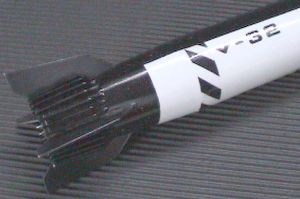 PROs: This is a
rocket that gets a tremendous amount of attention at the club launch and is
easy to fly. It's fairly hard to damage because of its size. It is cheap to
experiment on.
PROs: This is a
rocket that gets a tremendous amount of attention at the club launch and is
easy to fly. It's fairly hard to damage because of its size. It is cheap to
experiment on.
CONs: It's small and won't get the great cracklin' roar of a mid or high power rocket.
 |
 |